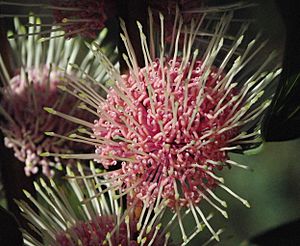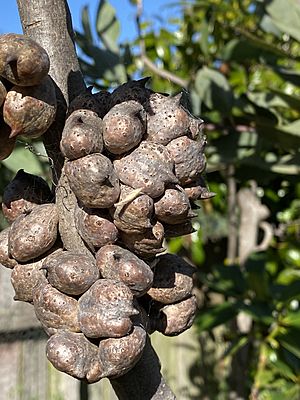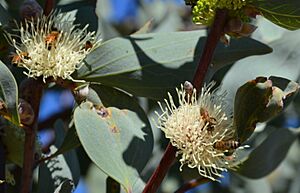Sea-urchin hakea facts for kids
Quick facts for kids Sea urchin hakea |
|
|---|---|
 |
|
| Scientific classification | |
| Genus: |
Hakea
|
| Species: |
petiolaris
|
 |
|
| Occurrence data from AVH | |
The Sea-urchin Hakea (Hakea petiolaris) is a cool shrub or small tree. It gets its name from its flowers, which look a bit like a sea urchin! This plant has creamy, pink, or purple flowers and hard, woody fruits. You can only find it in the southwest part of Australia. It often grows on old granite rocks, coastal areas, and in forests.
Contents
What the Sea-Urchin Hakea Looks Like
The Sea-urchin Hakea can grow as a tall shrub or even a small tree. It can reach up to 9 meters (about 30 feet) high. Its leaves are a special pale-grey color. They are usually between 5.5 and 15 cm (2-6 inches) long. The leaves are also 2.5 to 6 cm (1-2.5 inches) wide.
The flowers grow in round groups. These groups appear on small branches. Each group holds many flowers, usually 120 to 200 of them. Each tiny flower is about 1.4 to 1.8 cm (0.5-0.7 inches) long. They are white or cream. The outer parts of the flower, called the perianth, can be pink or purple.
After the flowers, the plant grows woody seed pods. These pods are 2 to 3.5 cm (0.8-1.4 inches) long. They are also 1 to 2 cm (0.4-0.8 inches) wide. Each pod splits open to release two dark brown or black seeds. These seeds have small wings to help them fly away.
How the Sea-Urchin Hakea Got Its Name
The Sea-urchin Hakea was first described in 1845. A scientist named Carl Meissner gave it its scientific name. He used plants collected by Ludwig Preiss.
The second part of its scientific name, petiolaris, comes from a Latin word. Petiolus means "small, slender stalk." This name refers to how the leaves grow on clear stalks.
There are three slightly different types of Sea-urchin Hakea. Scientists call these "subspecies." They mostly differ in their leaf sizes and flower colors as they get older.
- Subspecies petiolaris has flowers that turn darker. They become mauve (a light purple) and then pink. Its leaves are smaller than the other types. This type is a shrub or small tree, about 1 to 2 meters (3-6 feet) tall. It can regrow from a special woody base after a fire. It flowers in June.
- Subspecies trichophylla has flowers that turn mauve and then maroon. This type is a larger shrub or tree. It can grow taller than 3 meters (10 feet), sometimes reaching 9 meters (30 feet). After a fire, it regrows from seeds stored in its pods. It flowers from April to June. Its name, trichophylla, means "hairy leaf" in Greek. This is because its leaves have hairs that stay on them.
- Subspecies angusta has flowers that turn mauve and then pinkish-mauve. This type is a shrub or small tree, 1 to 2 meters (3-6 feet) tall. It flowers from March to May. Its name, angusta, is a Latin word meaning "narrow."
Where the Sea-Urchin Hakea Lives
The Sea-urchin Hakea grows in different parts of southwest Australia.
- Subspecies petiolaris grows in Jarrah forests. You can often find it near granite rocks. It lives between the Darling Range and York.
- Subspecies trichophylla also grows near granite rocks in shrubland. It is found near Wongan Hills. Some groups are also found near Kununoppin and east of Pingelly.
- Subspecies angusta is only found in a few small areas. It grows around granite rocks near Pingaring.
Protecting the Sea-Urchin Hakea
Good news! All three types of Sea-urchin Hakea are considered "not threatened." This means they are not in danger of disappearing. The Western Australian Government's Department of Parks and Wildlife keeps track of them.
Growing Sea-Urchin Hakea in Gardens
People can grow the Sea-urchin Hakea from its seeds. It grows into a large shrub or a tree up to 10 meters (33 feet) tall. It can spread about 2 meters (6.5 feet wide).
This plant is great for gardens! You can use it as a screen or a hedge. It also looks nice as a single plant. It grows quickly and is quite tough. It can handle frost and attracts birds. Many people like it for its beautiful flowers. The flowers are dull red with white parts. They appear in autumn or winter.
The most common type grown in gardens is H. petiolaris subspecies trichophylla.
How the Sea-Urchin Hakea Interacts with Nature
The way the flowers grow directly on the stem (called cauliflory) is interesting. This might be a leftover from a time when tall forests covered the area. Back then, birds and other animals would move through the dense leaves of smaller plants. This flower placement made it easier for them to pollinate the plant.
- Young, Jennifer (2000) Hakeas of Western Australia : botanical districts of Irwin and Darling - the Northern Sandplains and the South-west Forest West Perth, W.A.. ISBN: 0958577803
See also
 In Spanish: Hakea petiolaris para niños
In Spanish: Hakea petiolaris para niños



